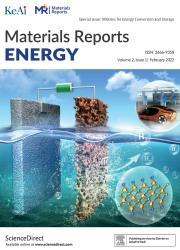由亲锂微通道引导的高度稳定的Li+沉积
IF 13.8
引用次数: 0
摘要
锂金属阳极(LMA)在镀/剥离锂离子过程中体积的反复变化、锂与电解液界面的易挥发性以及锂金属表面枝晶的不断生长严重阻碍了锂在构建高能量密度锂金属电池(lmb)中的实际应用。本文引入了一种新型的Li寄主(3D ZnO/CNTs/Cu),具有有序的微通道和微通道内壁上的亲锂性ZnO,诱导Li+均匀沉积到微通道中,最终抑制Li枝晶的形成。制备的3D锂基质结构稳定,可以适应锂离子电镀/剥离时的体积变化,从而提高电化学性能。采用三维ZnO/CNTs/Cu@Li阳极的对称电池在0.5和2 mA cm−2的面电流密度下表现出长周期稳定性;在1C下循环400次后,充满电池的可逆放电容量保持在105 mAh g−1,容量保持率为70%。同时,非原位SEM观察证明,三维ZnO/CNTs/Cu@Li阳极在充放电(或镀/剥离)过程中可以保持结构的完整性。本研究表明,在Li基质中添加亲锂纳米通道可以显著提高lmb的电化学性能和安全性。本文章由计算机程序翻译,如有差异,请以英文原文为准。

Highly stable Li+ deposition guided by a lithiophilic microchannel
The repeated volume variation of lithium (Li) metal anode (LMA) upon Li+ plating/stripping, the volatile interface between Li and the electrolyte, and the incessant growth of Li dendrites on Li metal surface have severely hindered the practical application of Li in constructing high energy-density Li metal batteries (LMBs). Herein, a novel Li host (3D ZnO/CNTs/Cu) featuring ordered microchannels and lithiophilic ZnO species on the inner walls of the microchannels is introduced, which induces the uniform Li+ deposition into the microchannels and finally suppresses the formation of Li dendrites. The stable structure of the fabricated 3D Li host can adapt to volume variations upon Li+ plating/stripping, thereby enhancing electrochemical performances. Symmetric cells with the 3D ZnO/CNTs/Cu@Li anode exhibited long cycle stability at areal current densities of 0.5 and 2 mA cm−2; Full cells maintained a reversible discharge capacity of 105 mAh g−1 after 400 cycles at 1C with a capacity retention of 70%. Meanwhile, ex-situ SEM observations proved that the 3D ZnO/CNTs/Cu@Li anode can keep the structural integrity during charging/discharging (or plating/stripping). This work suggested that lithiophilic nanochannels in the Li host can significantly improve the electrochemical performance and safety of LMBs.
求助全文
通过发布文献求助,成功后即可免费获取论文全文。
去求助
来源期刊

材料导报:能源(英文)
Renewable Energy, Sustainability and the Environment, Nanotechnology
CiteScore
13.00
自引率
0.00%
发文量
0
审稿时长
50 days
 求助内容:
求助内容: 应助结果提醒方式:
应助结果提醒方式:


